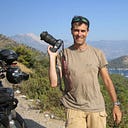Book review: Lisa Morrow’s “Istanbul 50 unsung places”
I was in love with Istanbul, once, and I used to love guidebooks too.
Then, while Istanbul turned into a giant open air shopping mall, plundered by hordes of savage tourists, my love for travel guidebooks faded too. Most of them felt like street indications on already crowded roads, and that was just not my idea of travel.
When I received this book as a gift, I sighed, but fond memories and a vague sense of guilt made me read it, like when you give a second chance to an old lover.
It was an inspired decision.
I read this book in summer, on a terrace by the sea, in Genoa, Italy, on a coast resembling more the Black Sea than the Mediterranean. And more than once, while my reader’s mind was lost in the maze of alleys and shadows where once Genoese tradesmen and sailors felt at home, I had to fight the instinct of just getting out and walking to the places described in this book: I was not there, after all.
The author, who lives and loves Istanbul, achieves a double miracle.
The first one is making me love travel guidebooks again. She wrote a step-by-step guide which feels more like a treasure map for explorers longing for the unexpected than a reassuring fetish for tourists wary of getting lost.
Far from lecturing travelers on “what to see” and “where to go,” the book provides ample background stories for the unsung places, reasons to visit them and background context where readers can look for new attractions or itineraries. At the same time, through the writer’s experiences and entertaining anecdotes, it makes sure that no visitor will be a stranger to the place. Tourists love feeling out of place in exotic destinations, but readers of this guide will have enough practical information to blend in and behave, if not like a local, at least like an informed traveler.
When I lived in Turkey, like any other yabanci I dreaded the inevitable moment when Italian friends or acquaintances announced their imminent visit to some tourist trap destination, and asked for advice. When we could not go with them, there was so much to explain to our clueless friends that we didn’t know where to start. From warning about scams without scaring them to explaining what transportation should be avoided and what was safer or cheaper, often we lazily advised them to rely on local guides or Tripadvisor.
I suspect that the author decided to write this book for this reason too, making life easier for all the people in Turkey who have foreign friends visiting: she solves the problem brilliantly, also providing enough off-the-beaten-path, but not minor destinations to placate the wanderlust of any Turkey lover.
The second, bigger miracle achieved by the book is to restore Istanbul to its exotic charm, with its history, its scents and hidden corners where any visitor can uncover something forgotten, far from the shining orientalist megatrap seen by sloppy tourists.
But by the time I finished it, I realized something else. The “guidebook” style is deceiving: in the best tradition of travel literature, the book is also a travel tale disguised as a guidebook, more a personal journal than a map. A book can be a trip by itself and when I turned the last page, I looked at the sea and felt like I had just been on the Bosphorus, my espresso was a Turkish coffee and I needed a lokum.
When I return to Istanbul, I will make a point of visiting at least some of these places, starting from those where I have already been but I missed things described by the author. Until then, I will have enjoyed in these pages the magic of the Stamboul as I like to remember it, and as I hope to see it again.
